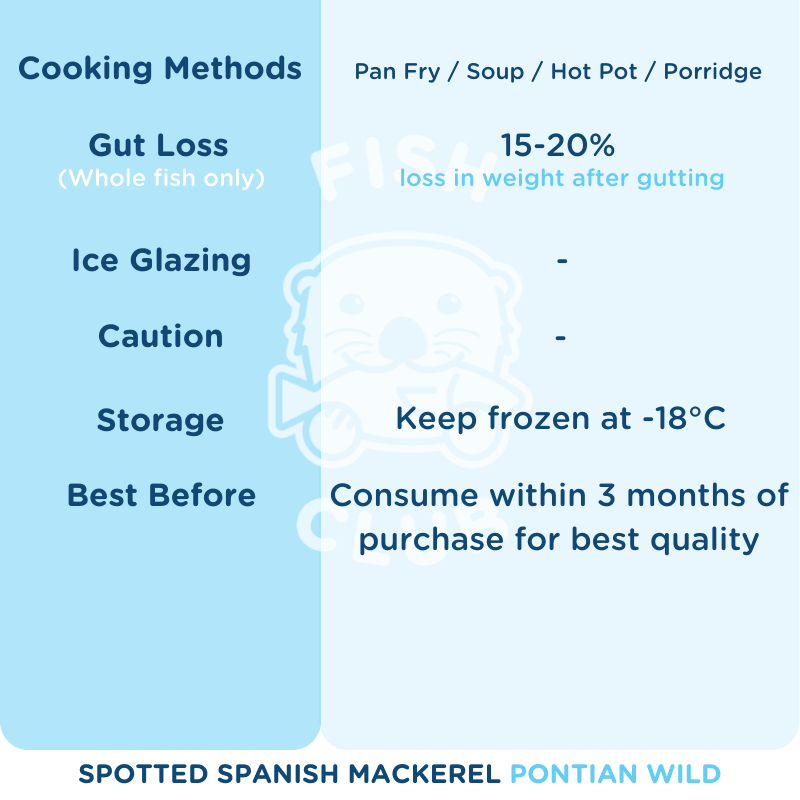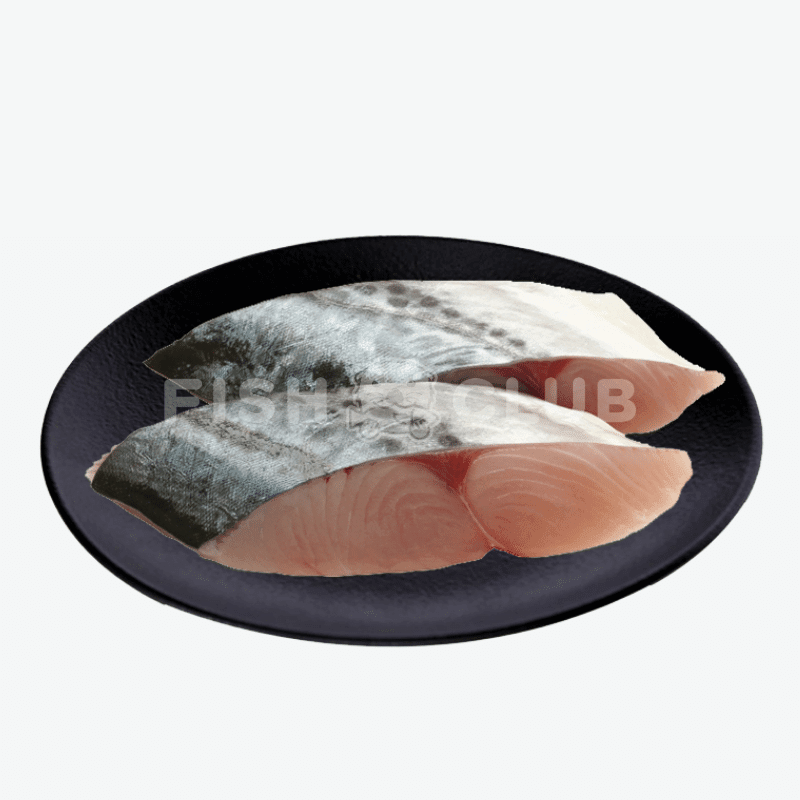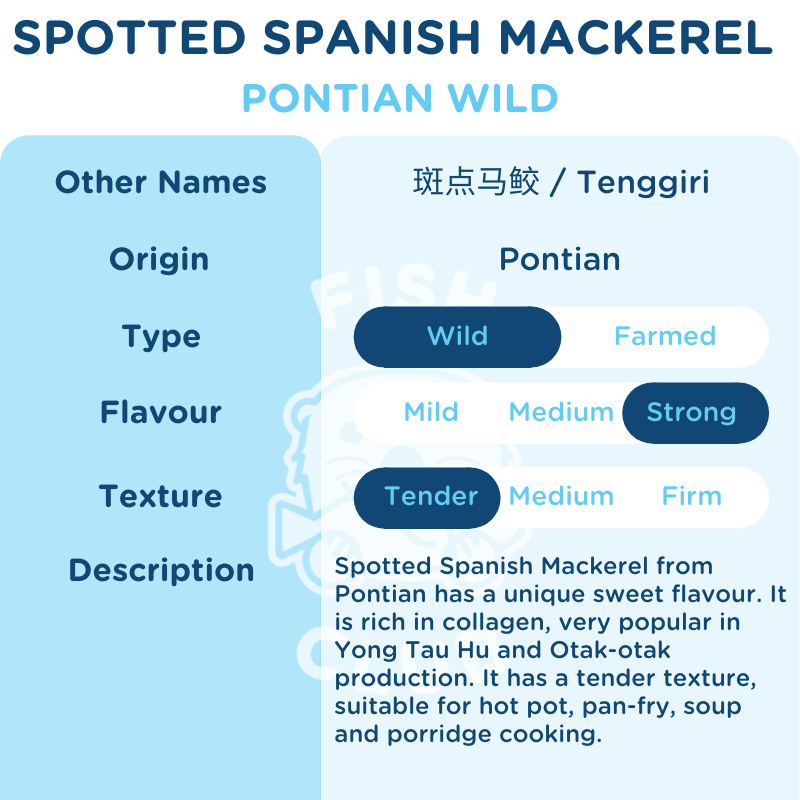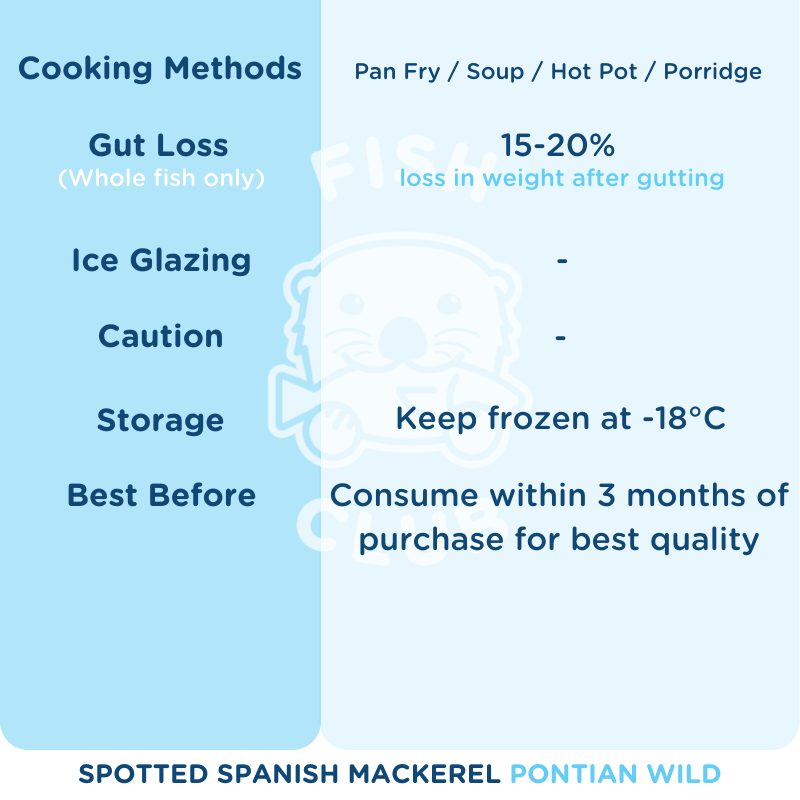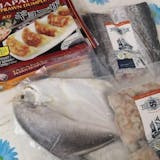Fish Club
Spotted Spanish Mackerel (Pontian Wild) Fillet / 斑点马鲛(笨珍野生)厚片
Spotted Spanish Mackerel (Pontian Wild) Fillet / 斑点马鲛(笨珍野生)厚片
SKU:TGR-F-200
Origin: Pontian
37 in stock
Couldn't load pickup availability
- Origin: Pontian / 产地:笨珍
- Wild Caught / 野生捕捞
- 100% Preservatives Free / 绝无防腐
- For best quality, consume within 3 months from purchase / 购买后3个月内食用,品质最佳
Spotted Spanish Mackerel 斑点马鲛
Spotted Spanish Mackerel (Tenggiri) from Pontian has a hint of sweet taste in its savoury flavour that is unique and cannot be found elsewhere. Spotted Spanish Mackerel is often associated and confused with Korean Seerfish (Tat Pan) and Spanish Mackerel (Batang). Despite similar appearances, their taste and flavours can be differentiated. Among the three, Spotted Spanish Mackerel is the richest in collagen. The fish is very popularly used in making local cuisines such as Yong Tau Hu and Otak-otak because of its tender texture. It is also suitable for hot pot, pan-fry, soup and porridge. 笨珍野生的斑点马鲛有别于来自其他海域的斑点马鲛,它的口味更加清甜。许多人常把斑点马鲛,巴当鲛鱼和大板鲛鱼混淆。其实,斑点马鲛是这三种鱼之中胶原蛋白含量最高的鱼。它非常地受欢迎,广泛用于制作本地美食如酿豆腐和乌达。它口感柔软,适合放入火锅、汤和粥或者用于煎炸。 Chinese Name(s): 斑点马鲛 Local Name(s): Tenggiri Origin: Pontian 产地:笨珍 Type: Wild Caught 种类:野生 Flavour: Strong 口味:浓郁 Texture: Tender 肉质:柔软 Cooking Method: Pan Fry / Soup / Hot Pot / Porridge 烹煮方式:煎炸 / 汤 / 火锅 / 粥 Weight Loss after cleaning (whole fish): 15-20% 清理后重量减少(全鱼):15-20% Caution: Customized cutting is NOT available. 注意:恕不接受客制化切割 Storage: Keep frozen at -18°C. For best quality, consume within 3 months. 储存方式:冷冻雪藏 -18°C。购买后3个月内食用,品质最佳。 ✅ 100% Preservative Free 绝无防腐 ✅ Cleaned & Gutted 去鳞清内脏 ✅ Vacuum Packed 真空包装 ✅ Flash Frozen 急速冷冻 ————————————————————————————————————————Spanish Mackeral vs Spotted Spanish Mackerel vs Korean Seerfish
Spanish Mackeral, Narrow-Barred Mackeral Scomberomorus commerson Teochew / Hokkien: Batang Mandarin 马鲛鱼 (ma jiao yu) Malay: Tengiri Batang The Spanish Mackeral, locally known as batang, is a popular food fish in Singapore. It is commonly used for fish soups and otah. They belong to the family Scombridae which are a pelagic species whose members include tuna. They have no scales and underneath their silvery skin is a muscular flesh which is rich in blood vessels as they are strong swimmers and would often speed across the open waters of the oceans and seas. The flesh is meaty and firm, almost like the texture of chicken breast meat when it is fried. The price of batang ranges from $7/kg to $22/kg. You can usually buy a reasonably good quality one in the range of $12/kg. As with all fish, freshness is the key. So, the fish which are caught in local waters in small, day boats are usually better quality as they are fresher. These will command premium prices. Batang which are caught in Ujang Pandang (now known as Makassar) in South Sulawesi are also regarded to be superior in taste. These are airflown to Singapore. The Batang is easy to identify. It is usually the largest of the three closely related species of mackerals that are found in our local markets and it is the only one with vertical bars on the body. My fishmonger tells me to always look out for batang whose cross section is more narrow and sleek as they will taste better than those rounder ones. Another thing to look out for is for fish that have been line caught rather than netted. Fish that have been caught in nets usually have some bruises to the skin and are more traumatised than line caught fish and will not taste as good.
Spotted Spanish Mackeral, Indo-Pacific King Mackeral Scomberomorus guttatus Teochew/Hokkien: Beh Kah Mandarin 马鲛鱼 (ma jiao yu), 斑点马鲛 (ban dian ma jiao) Malay: Ikan Tenggiri Papan, Tenggiri Bunga The Spotted Spanish Mackeral is a smaller fish compared to the batang. It is usually about 30-50cm in size. Like the batang, the best ones are fished locally from small boats. I have heard a few fishmongers say that the best ones come from Pengarang, which is quite close to Singapore. This is a very good fish to use for fish balls as well as otah. Of course, if the fish is super fresh, you should just slice it and use it for fish soup!
Korean Seerfish Scomberomorus koreanus Teochew/Hokkien: Dua Pan Mandarin: 马鲛鱼 (ma jiao yu) Malay: Ikan Tenggiri Korea Of the three, the Korean Seerfish is the least commonly available and the most preferred. The flesh is a little sweeter and more delicate than the batang and fish soup stalls that say they serve dua pan instead of batang are the ones you should pay more attention to. They are typically larger than the beh kah but smaller than batang. Because of their spots, they can sometimes be mistaken for a large beh kah. They are usually broader (ie the length between dorsal ie top and ventral fins) and their is a more distinct hump above the eyes which make them look a bit “fiercer” than the beh kah. Victor, my fishmonger at Kovan market tells me that the best dua pan comes from Tanjung Balai in Indonesia. This fish usually costs around $20-$25/kg.
COMPARISON
Additional Information:
Caution: Customized cutting is NOT available.注意:恕不接受客制化切割
Storage: Keep frozen at -18°C. For best quality, consume within 3 months.
储存方式:冷冻雪藏 -18°C。购买后3个月内食用,品质最佳。
✅ 100% Preservative Free 绝无防腐
✅ Cleaned & Gutted 去鳞清内脏
✅ Vacuum Packed 真空包装
✅ Flash Frozen 急速冷冻
How we package your order?
How we package your order?
The vacuum sealed seafood products and frozen chill packs, which contain non-toxic gel are packed in a polystyrene box, so the chill packs distribute the cold evenly throughout your fish and seafood, ensuring maximum freshness.
We seal the polystyrene box with packing tape and hand it to our cold chain logistic to deliver to you.
What should I do when my order arrives?
What should I do when my order arrives?
Remove your seafood products as soon as possible from the box, refrigerate all fresh items and freeze all frozen goods until you are ready to prepare them for consumption.
How is your frozen seafood handled? What is your freezing process?
How is your frozen seafood handled? What is your freezing process?
Our fish and shellfish are processed and immediately frozen in our -45°c blast freezer. No chemicals or preservatives are added during the freezing or production process on any of our seafood items.
What is a -45 Degree Freezer and how does it affect the seafood when defrosted?
What is a -45 Degree Freezer and how does it affect the seafood when defrosted?
Blast freezing seafood products at a lower temperature keeps the wall of the cell intact, ensuring that water from the inside does not exit. When defrosted, the quality, texture, and appearance will remain completely intact just as if it were a fresh product.
What is the proper way to defrost frozen seafood products?
What is the proper way to defrost frozen seafood products?
If you have received frozen seafood and placed it in the freezer, remove these items from the freezer and store them in the refrigerator for at least one day before you plan to serve it. Allow 12 to 24 hours for the product to properly defrost. Do not rush the defrosting process as it can affect the flavor and texture of your seafood.
Why are some seafood products unavailable from time-to-time?
Why are some seafood products unavailable from time-to-time?
The availability of seafood products depends upon the season, weather, and other conditions that can affect a catch or harvest. Additionally, the harvesting of many seafood products is regulated in order to maintain a sustainable supply.


